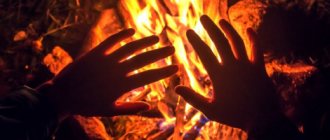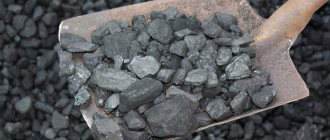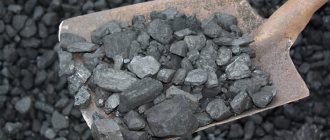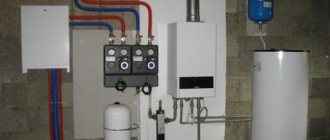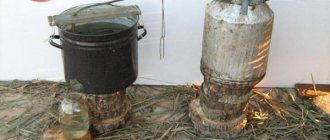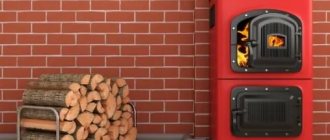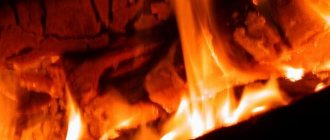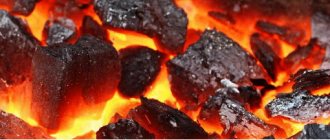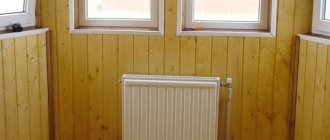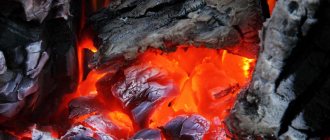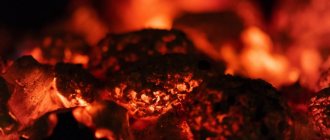Substances of organic origin include fuels that, when burned, release a certain amount of thermal energy. Heat production must be characterized by high efficiency and the absence of side effects, in particular, substances harmful to human health and the environment.
If we consider fuel from the perspective of its state of aggregation, then the structure of the substance can be divided into two components according to the degree of flammability. The combustible part includes such chemical elements as hydrogen and carbon, which generally represent a hydrocarbon mixture, as well as sulfur. The non-flammable component contains water, mineral salts and the following elements: oxygen, nitrogen and a number of metals.
Complete combustion of 1 kg of fuel, consisting of the above components, contributes to the release of varying amounts of thermal energy. Any substance is evaluated according to such an indicator as the heat of combustion.
The heat of combustion of a fuel (HCT), measured in kJ/kg, refers to the amount of energy that is released as a result of the complete combustion of 1 kg of a substance. This indicator is formed at two levels. Higher TST is formed due to the process of condensation of water present in combustion products. When determining the lowest TST, its previous degree is not taken into account.
Thus, the calculation of heat in internal combustion engines is usually based on the lowest value. This can be explained quite simply: the process of liquid condensation is impossible in the cylinders. To establish TST, a calorimetric bomb is used, in which compressed oxygen is saturated with water vapor. A sample of a certain type of fuel is placed in this environment, then the results are analyzed.
For petroleum substances, TCT is calculated using the following formulas:
QВ = 33913ω(С) + 102995 ω(Н) – 10885 ω(O – S),
QH = QB – 2512 ω(H2O),
where ω(C, H, O, S) – mass fractions of elements in the fuel, %;
ω(H2O) – the amount of water vapor in the combustion products of one kg of material, %.
Each type of substance, which differs in chemical composition, has its own TST. The most popular types of solid fuel include:
- firewood and coal;
- pellets and briquettes.
Let's look at each type separately.
Firewood
These are sawn or chopped pieces of wood, which, when burned in furnaces, boilers and other devices, generate thermal energy.
For ease of loading into the firebox, wood material is cut into individual elements up to 30 cm long. To increase the efficiency of their use, the firewood must be as dry as possible and the combustion process must be relatively slow. In many respects, wood from hardwoods such as oak and birch, hazel and ash, and hawthorn are suitable for heating premises. Due to the high resin content, increased burning rate and low calorific value, coniferous trees are significantly inferior in this regard.
Coal boilers
The combustion mirror of the boiler furnace has the largest and evenly distributed area of air supply into the brown coal layer. A wide field of small-diameter holes makes it possible to accelerate the combustion of brown coal due to the force of air jets and ensure complete combustion of the fuel without the formation of zones with a lack of oxygen. The optimal combustion mode allows not only to more efficiently burn the fuel supplied to the grate, but also eliminates the dependence of the combustion efficiency of the fuel on its type, and properties in terms of caking, ash content and fractionation. It has been experimentally proven that the use of RVR alone can reduce mechanical and chemical underburning, and thereby increase the efficiency associated with active combustion and failure by 5%.
In boilers with RVR furnace, maximum efficiency of burning low-grade brown fuel is achieved.
In addition, boilers with RVR combustion chambers also effectively burn wood fuel. Mechanical underburning in the RVR furnace when burning wood fuel is 1%. Wood fuel has a low ash content of about 2%, with forced combustion there is an intensive supply of air and complete burning of wood fuel to the state of dust. 2% of the ash residue is deposited in the rotary box of the convective heating surfaces, where there is an ash door, or is carried away with the flue gases into the chimney.
When burning wood fuel in an RVR furnace, there is no need to remove unburned pieces of fuel from the grate, since with an intense, evenly distributed air supply, almost complete combustion of the fuel occurs. For comparison, the mechanical underburning on the grate is 5%, since through large holes in the cast iron grates, unburned pieces of wood fuel and wood coke fall through, the heat they generate is not utilized by the heating surfaces of the combustion chamber, but cools in the combustion box.
Coal
It is a natural material of plant origin, extracted from sedimentary rock.
This type of solid fuel contains carbon and other chemical elements. There is a division of material into types depending on its age. Brown coal is considered the youngest, followed by hard coal, and anthracite is older than all other types. The age of a combustible substance also determines its moisture content, which is more present in young material.
During the combustion of coal, environmental pollution occurs, and slag is formed on the boiler grates, which to a certain extent creates an obstacle to normal combustion. The presence of sulfur in the material is also an unfavorable factor for the atmosphere, since in the air space this element is converted into sulfuric acid.
However, consumers should not fear for their health. Manufacturers of this material, taking care of private customers, strive to reduce the sulfur content in it. The heating value of coal can vary even within the same type. The difference depends on the characteristics of the subspecies and its mineral content, as well as the geography of production. As a solid fuel, not only pure coal is found, but also low-enriched coal slag, pressed into briquettes.
| Type of coal | Specific heat of combustion of the material | |
| kJ/kg | kcal/kg | |
| Brown | 14 700 | 3 500 |
| Stone | 29 300 | 7 000 |
| Anthracite | 31 000 | 7 400 |
Types of fuel for solid fuel boilers and a comparative table of their calorific value
Main types of fuel for solid fuel boilers:
— Firewood
— Pellets (fuel granules)
— Fuel briquettes
- Coal
Firewood
Firewood is sawn or chopped pieces of wood intended for burning in stoves, fireplaces, etc. to produce heat, heat and light.
The moisture content should be as low as possible.
Fireplace wood is about 25 - 33 cm long.
The priority characteristics of firewood for fireplaces and stoves are their calorific value, burning time and comfort during use (flame pattern, smell).
For heating purposes, it is important that heat release occurs more slowly, but over a longer period of time.
For heating purposes, all hardwood firewood is best suited, including oak, ash, birch, hazel, yew, and hawthorn.
Features of burning firewood of different types of wood:
- firewood from beech, birch, ash, hazel is difficult to melt, but they can burn damp because they have little moisture, and firewood from all these tree species, except beech, splits easily;
— alder and aspen burn without the formation of soot and even burn it out of the chimney;
— birch firewood is good for heat, but if there is not enough air in the firebox, it burns smoky and forms tar (birch resin), which settles on the walls of the pipe;
— pine firewood burns hotter than spruce firewood due to its higher resin content, with sparking when the temperature rises sharply;
— oak and hornbeam have better heat transfer during combustion, but do not split easily;
— firewood from pear and apple trees splits easily and burns well;
- firewood made from medium-hard rocks, easy to split;
- cedar produces long-smoldering coals;
— cherry and elm wood smokes when burned;
— sycamore firewood melts easily, but is difficult to split;
— coniferous wood has a low calorific value, smokes and sparks, contributing to the formation of resinous deposits in the pipe, but easily splits and melts;
— poplar and linden burn well, spark strongly and burn out very quickly.
The calorific value of firewood of different types of wood varies greatly, which entails fluctuations in the density of wood and fluctuations in the conversion factors cubic meter => storage meter.
Table with average calorific values per 1 meter of firewood.
| Firewood (natural drying) | Calorific value, kWh/kg | Calorific value, mega Joule/kg | Calorific value, MWh/storage meter | Bulk density, kg/dm³ | Density, kg/storage meter |
| Hornbeam firewood | 4,2 | 15 | 2,1 | 0,72 | 495 |
| Beech firewood | 4,2 | 15 | 2,0 | 0,69 | 480 |
| Ash firewood | 4,2 | 15 | 2,0 | 0,69 | 480 |
| Oak firewood | 4,2 | 15 | 2,0 | 0,67 | 470 |
| Birch firewood | 4,2 | 15 | 1,9 | 0.65 | 450 |
| Larch firewood | 4,3 | 15,5 | 1,8 | 0,59 | 420 |
| Pine firewood | 4,3 | 15,5 | 1,6 | 0,52 | 360 |
| Spruce firewood | 4,3 | 15,5 | 1,4 | 0,47 | 330 |
1 storage meter of dry wood from deciduous trees replaces 200 - 210 liters of liquid fuel or 200 - 210 m³ of natural gas.
Pellets
Pellets (fuel granules) are natural raw materials of plant origin pressed under high pressure in the form of cylindrical granules of standard size.
The raw materials for their production are bark, sawdust, wood chips and other logging waste, and agricultural waste (sunflower husks, straw, substandard flax, etc.), as well as organic packaging materials, cardboard containers, etc.
The pellet production process consists of the stages: crushing, drying and granulation.
The raw materials are ground to the state of flour, then thoroughly dried and compressed into standard size granules using special equipment - a granulator.
During granulation, accompanied by an increase in the temperature of the material, the lignin polymer contained in it, contained in the cells of plant materials, tightly glues the crushed particles together. Chemical binders are not used.
The output is light, inexpensive, easy to store and absolutely safe fuel, an alternative to traditional fuels (coal, peat, firewood, natural gas).
The press granulator gives the pellets their shape.
Pellets are a modern universal type of biofuel, equivalent in efficiency to coal.
Types of pellets:
— obtained by processing round timber of hard and soft trees;
— obtained by processing straw;
— obtained processing of sunflower husks;
— obtained by processing cobs and stalks of corn;
- peat.
Advantage of pellets:
- environmentally friendly fuel corresponding to green technology, produced from materials that are harmless to humans and the environment and subject to recycling: 10-50 times lower carbon dioxide (CO2) emissions into the environment, 15-20 times lower ash formation than during combustion coal;
— unlimited production, including from low-quality wood,
- lower cost compared to the price of coal, liquid fuel or firewood,
— ease of transportation, both in packaged bags and in bulk, and unloading through sleeves with the possibility of automating the process;
- do not require large storage areas and can be stored outdoors without swelling or rotting,
- do not spontaneously ignite during storage,
— do not require additional processing before use, no worse than gas or coal.
- greater calorific value than sawdust and wood chips, 1.5 times more than firewood,
— when burning 1.9 tons of pellets, approximately the same amount of heat is released as when burning 1 ton of fuel oil, while the cost of pellets on the domestic market is 3 times cheaper, that is, heating with pellets is 40% cheaper than fuel oil;
— almost complete combustion with a minimum amount of slag, which reduces the frequency of boiler cleaning and can be done much less frequently,
— automation of loading pellets into the firebox in industrial conditions is possible,
- adjustment of household heating devices operating on pellets is adjusted automatically,
— low price volatility, since the price is internal,
- pellet boilers last longer, require less maintenance and are more economical,
Application of pellets:
- for heating residential buildings by combustion in stoves, fireplaces and boilers,
— to provide heat and electricity to industrial facilities and small settlements (using large granules with a high content of tree bark.
The demand for this alternative fuel and for equipment for its production and combustion is constantly increasing.
Comparative characteristics of fuel types
| Type of fuel | Heat of combustion MJ/kg | % sulfur | % ash | Carbon dioxide kg/GJ |
| Coal | 15 — 25 | 1-3 | 10 — 35 | 60 |
| Motor fuel | 42,5 | 0,2 | 1 | 78 |
| Fuel oil | 42 | 1,2 | 1,5 | 78 |
| Wood chips | 10 | 0 | 2 | 0 |
| Wood pellets | 17,5 | 0,1 | 1 | 0 |
| Peat granules | 10 | 0 | 20 | 70 |
| Straw pellets | 14,5 | 0,2 | 4 | 0 |
| Natural gas | 35 – 38 MJ/m3 | 0 | 0 | 57 |
Note:
“0” means that when a product is burned, the amount of CO2 released does not exceed the volume that is formed during natural decomposition, and the amount of other harmful emissions is negligible.
- Measurement of calorific value in Kcal/kg. 1 calorie is the amount of heat required to heat 1 g of water by 1°C. 4,500 Cal/kg ( 4,500 Cal/kg ) - heat of combustion of 1 kg of fuel in Cal.
- Measurement of calorific value in MJ/kg. System international thermal unit. 1 Calorie = 4.19 Joules, 4.500 Kcal/kg * 4.19 J = 18.855 MJ/kg - heat of combustion of 1 kg of fuel in Joules.
- Measurement of calorific value in kW*hour. 5.238 kW* hour/kg is the heat of combustion of 1 kg of fuel, measured in “electrical units”. The amount of energy released per second (that is, thermal power) = 18,855,000 J (see point 2) / 3600 sec = 5238 J/sec = 5,238 kWh.
Table 1. Heat transfer of pellets and alternative energy sources
| Type of fuel | Thermal capacity kcal/kg |
| Pellets | 4500 |
| Firewood | 2500 |
| Charcoal | 7500 |
| Coal | 7400 |
| Fuel oil | 9800 |
| Diesel fuel | 10200 |
| Natural gas | 8300 |
Pellet production standards:
— in the USA: Standard Regulations & Standards for Pellets in the US: The PFI (pellet), which is allowed to produce Premium and Standard pellets. Premium, which makes up about 95% of pellets produced in the United States, is no more than 1% ash, and Standard is no more than 3%. Premium can be used for heating any buildings. The Standard variety contains a larger volume of bark or agricultural waste. The standards also determine the density, size of pellets, humidity, dust content and other substances.
- in Germany: DIN 51731, in Austria: ONORM M-7135, in the UK: The British BioGen Code of Practice for biofuel (pellets), in Switzerland: SN 166000, in Sweden: SS 187120.
Basic European quality standards for fuel pellets
| Parameter | DIN 51 731 | O-Norm M-7135 | DINplus | SS187120 |
| Germany | Austria | Germany | Sweden | |
| Diameter (mm) | 4-10 | 4-10 | ||
| Length (mm) | < 50 | < 5*d | < 5*d | < 5*d |
| Density (kg/dm3) | > 1,0-1,4 | > 1,12 | > 1,12 | No |
| Humidity (%) | < 12 | < 10 | < 10 | < 10 |
| Bulk mass (kg/m3) | 650 | 650 | 650 | 650 |
| Briquette dust (%) | No | < 2,3 | < 2,3 | No |
| Ash content (%) | < 1,5 | < 0,5 | < 0,5 | < 1,5 |
| Heat of combustion (MJ/kg) | 17,5-19,5 | > 18 | > 18 | > 18 |
| Sulfur content (%) | < 0,08 | < 0,04 | < 0,04 | < 0,08 |
| Nitrogen content (%) | < 0,3 | < 0,3 | < 0,3 | No |
| Chlorine content (%) | < 0,03 | < 0,02 | < 0,02 | < 0,03 |
| Arsenic (mg/kg) | < 0,8 | No | < 0,8 | No |
| Lead (mg/kg) | < 10 | No | < 10 | No |
| Cadmium (mg/kg) | < 0,5 | No | < 0,5 | No |
| Chromium (mg/kg) | < 8 | No | < 8 | No |
| Copper(mg/kg) | < 5 | No | < 5 | No |
| Mercury(mg/kg) | < 1,5 | No | < 1,5 | No |
| Zinc(mg/kg) | < 100 | No | < 100 | No |
| Fixer, binding materials (%) | No | < 2 | < 2 |
* “no” does not mean a value, it may be, there is no information, it is not defined, there is no exact value, etc.
Fuel briquettes
Fuel briquettes are compressed wood waste (shavings, wood chips), agricultural waste (straw, sunflower seed husks, buckwheat), as well as peat.
The binder is a natural polymer lignin. Chemical binders are not used.
Fuel briquettes are actively used for heating private homes in various types of fireboxes (stoves), wood-burning boilers, fireplaces, and when cooking on the grill.
Advantages of fuel briquettes:
- an environmentally friendly product, the material of which is entirely natural raw materials, and
- not affected by fungi,
— burns 2-4 times longer than wood,
— convenient to store and use.
- high calorific value comparable to coal, on average 2 times higher in comparison with conventional firewood,
— constant temperature at each stage of combustion due to an even flame,
— ash content after combustion — 1-3%. For comparison: the ash content after burning coal is 30-40%, firewood is 8-16%, wood chips is 11-18%,
- modern solid fuel boilers using briquettes can be cleaned no more than once a year,
- ash can be used as an environmentally friendly fertilizer,
— carbon monoxide is not released and other harmful substances are not formed,
— heating costs are lower than when using coal or firewood.
Types of fuel briquettes:
— RUF briquettes — in the form of a large rectangular brick,
— NESTRO briquettes — a cylindrical briquette, sometimes with a radial hole inside,
— Pini&Kay briquettes are a briquette having 4, 6 or 8 sides with a longitudinal radial hole inside.
Coal
Coal is a combustible sedimentary rock of plant origin, consisting mainly of carbon and a number of other chemical elements.
The composition of coal depends on the age and conditions of coalification:
— brown coal is the youngest,
- coal,
— anthracite is the oldest.
With aging, carbon concentration occurred and the content of volatile components, in particular moisture, decreased.
Brown coal has a moisture content of 30-40%, more than 50% of volatile components; for anthracite, these 2 indicators are 5-7%.
The moisture content of coal is 12-16%, the amount of volatile components is about 40%.
Coal also contains various non-combustible ash-forming additives, "rock".
The ash pollutes the environment and is sintered into slag on the grate, which makes it difficult to burn coal.
The presence of rock reduces the specific heat of combustion of coal.
Depending on the type and mining conditions, the amount of minerals varies greatly; the ash content of hard coal is about 15% (10-20%).
A harmful component of coal is also sulfur, during the combustion of which oxides are formed, which in the air turn into sulfuric acid.
Specific heat of combustion (coal concentrate)
| Type of coal | Specific heat of combustion of coal | |
| kJ/kg | kcal/kg | |
| Brown | 14 700 | 3 500 |
| Stone | 29 300 | 7 000 |
| Anthracite | 31 000 | 7 400 |
Actual figures may vary significantly.
Kuzbass hard coal - 5000-5500 kcal/kg. .
The density of coal is 1 - 1.7 (hard coal - 1.3-1.4) g/cm3, depending on the type and content of mineral substances.
The “bulk density” indicator is used, which is about 800-1,000 kg/m3.
Types and grades of coal
Coal is classified according to many parameters (geography of production, chemical composition), but from a “everyday” point of view, it is enough to know the labeling and possibilities of use.
The following coal designation system is used: Grade = (grade) + (size class).
| Brown | B | |
| Stone | Long flame | D |
| Gas | G | |
| Fat | AND | |
| Coke | TO | |
| Lean-sintering | OS | |
| Low-caking | SS | |
| Skinny | T | |
| Anthracites | A | |
In addition to the main grades, there are intermediate grades of coal: DG (long-flame gas), GZh (gas fat), KZh (coke fat), PA (semi-anthracite), brown coals are also divided into groups.
Coking grades of coal (G, coke, Zh, K, OS) are practically not used in thermal power engineering, since they are a scarce raw material for the coke-chemical industry.
According to the size class (size of pieces, fractions), graded coal is divided into:
| P | Slab | more than 100 mm |
| TO | Large | 50-100 mm |
| ABOUT | Nut | 26-50 mm |
| M | Small | 13-25 mm |
| WITH | seed | 6-13 mm |
| Sh | Shtyb | less than 6 mm |
| R | Private | not limited by size |
In addition to graded coal, there are combined fractions and screenings available for sale (PK, KO, OM, MS, SSh, MSSh, OMSSh).
The size of coal is determined based on the smaller value of the finest fraction and the larger value of the largest fraction indicated in the name of the coal grade.
For example, the OM fraction (M - 13-25, O - 25-50) is 13-50 mm.
In addition to the above-mentioned types of coal, you can find coal briquettes on sale, which are pressed from low-enriched coal slurry.
Coal combustion process
Coal consists of 2 flammable components: volatile substances and solid (coke) residue
At the 1st stage of combustion, volatile substances are released; When there is an excess of oxygen, they burn quickly, producing a long flame but little heat.
At the 2nd stage, the coke residue burns out; the intensity of its combustion and ignition temperature depend on the degree of coalification, that is, on the type of coal (brown, hard, anthracite).
The higher the degree of carbonization (the highest is for anthracite), the higher the ignition temperature and heat of combustion, but the lower the combustion intensity.
Coal grades B, D, G
Due to the high content of volatile substances, such coal flares up quickly and burns out quickly.
Coal of these grades is available and suitable for almost all types of boilers, however, for complete combustion, this coal must be supplied in small portions so that the released volatile substances have time to completely combine with oxygen in the air.
Complete combustion of coal is characterized by a yellow flame and clear flue gases; incomplete combustion of volatile substances produces a purple flame and black smoke
To effectively burn such coal, the process must be constantly monitored.
Coal grades SS, T, A
It is more difficult to light, but it burns for a long time and produces much more heat.
Coal can be loaded in large batches, since they burn mainly coke residue and there is no mass release of volatile substances.
The blowing mode is very important, since if there is a lack of air, combustion occurs slowly, it may stop, or, on the contrary, an excessive increase in temperature, leading to heat loss and burnout of the boiler.
Comparative table of calorific value of some types of fuel
The calorific value of fuel characterizes the amount of heat released during complete combustion of fuel weighing 1 kg or volume 1 m³ (1 l).
Most often, calorific value is measured in J/kg (J/m³; J/l).
The higher the specific heat of combustion of the fuel, the lower its consumption.
The specific heat of combustion of each type of fuel depends on:
— from its flammable components (carbon, hydrogen, volatile combustible sulfur, etc.);
- from its humidity and ash content.
| Type of fuel | Unit change | Specific heat of combustion | Equivalent | ||||
| kcal | kW | MJ | Natural gas, m3 | Dis. fuel, l | Fuel oil, l | ||
| Electricity | 1 kW/h | 864 | 1,0 | 3,62 | 0,108 | 0,084 | 0,089 |
| Diesel fuel (diesel fuel) | 1 l | 10300 | 11,9 | 43,12 | 1,288 | — | 1,062 |
| Fuel oil | 1 l | 9700 | 11,2 | 40,61 | 1,213 | 0,942 | — |
| Kerosene | 1 l | 10400 | 12,0 | 43,50 | 1,300 | 1,010 | 1,072 |
| Oil | 1 l | 10500 | 12,2 | 44,00 | 1,313 | 1,019 | 1,082 |
| Petrol | 1 l | 10500 | 12,2 | 44,00 | 1,313 | 1,019 | 1,082 |
| Natural gas | 1 m3 | 8000 | 9,3 | 33,50 | — | 0,777 | 0,825 |
| Liquefied gas | 1 kg | 10800 | 12,5 | 45,20 | 1,350 | 1,049 | 1,113 |
| Methane | 1 m3 | 11950 | 13,8 | 50,03 | 1,494 | 1,160 | 1,232 |
| Propane | 1 m3 | 10885 | 12,6 | 45,57 | 1,361 | 1,057 | 1,122 |
| Ethylene | 1 m3 | 11470 | 13,3 | 48,02 | 1,434 | 1,114 | 1,182 |
| Hydrogen | 1 m3 | 28700 | 33,2 | 120,00 | 3,588 | 2,786 | 2,959 |
| Coal (W=10%) | 1 kg | 6450 | 7,5 | 27,00 | 0,806 | 0,626 | 0,665 |
| Brown coal (W=30…40%) | 1 kg | 3100 | 3,6 | 12,98 | 0,388 | 0,301 | 0,320 |
| Coal-anthracite | 1 kg | 6700 | 7,8 | 28,05 | 0,838 | 0,650 | 0,691 |
| Charcoal | 1 kg | 6510 | 7,5 | 27,26 | 0,814 | 0,632 | 0,671 |
| Peat (W=40%) | 1 kg | 2900 | 3,6 | 12,10 | 0,363 | 0,282 | 0,299 |
| Peat briquettes (W=15%) | 1 kg | 4200 | 4,9 | 17,58 | 0,525 | 0,408 | 0,433 |
| Peat crumbs | 1 kg | 2590 | 3,0 | 10,84 | 0,324 | 0,251 | 0,267 |
| Wood pellets | 1 kg | 4100 | 4,7 | 17,17 | 0,513 | 0,398 | 0,423 |
| Straw pellets | 1 kg | 3465 | 4,0 | 14,51 | 0,433 | 0,336 | 0,357 |
| Sunflower husk pellets | 1 kg | 4320 | 5,0 | 18,09 | 0,540 | 0,419 | 0,445 |
| Freshly cut wood (W=50…60%) | 1 kg | 1940 | 2,2 | 8,12 | 0,243 | 0,188 | 0,200 |
| Dried wood (W=20%) | 1 kg | 3400 | 3,9 | 14,24 | 0,425 | 0,330 | 0,351 |
| wood chips | 1 kg | 2610 | 3,0 | 10,93 | 0,326 | 0,253 | 0,269 |
| Sawdust | 1 kg | 2000 | 2,3 | 8,37 | 0,250 | 0,194 | 0,206 |
| Paper | 1 kg | 3970 | 4,6 | 16,62 | 0,496 | 0,385 | 0,409 |
| Sunflower husk, soybean | 1 kg | 4060 | 4,7 | 17,00 | 0,508 | 0,394 | 0,419 |
| Rice husk | 1 kg | 3180 | 3,7 | 13,31 | 0,398 | 0,309 | 0,328 |
| Linen bonfire | 1 kg | 3805 | 4,4 | 15,93 | 0,477 | 0,369 | 0,392 |
| Corn on the cob (W>10%) | 1 kg | 3500 | 4,0 | 14,65 | 0,438 | 0,340 | 0,361 |
| Straw | 1 kg | 3750 | 4,3 | 15,70 | 0,469 | 0,364 | 0,387 |
| Cotton stalks | 1 kg | 3470 | 4,0 | 14,53 | 0,434 | 0,337 | 0,358 |
| Grapevine (W=20%) | 1 kg | 3345 | 3,9 | 14,00 | 0,418 | 0,325 | 0,345 |
Pellets
Pellets (fuel granules) are solid fuels created industrially from wood and plant waste: shavings, bark, cardboard, straw.
The raw material, crushed to dust, is dried and poured into a granulator, from where it comes out in the form of granules of a certain shape. To add viscosity to the mass, a plant polymer, lignin, is used. The complexity of the production process and high demand determine the cost of pellets. The material is used in specially equipped boilers.
Briquettes
Briquettes are solid fuels that are in many ways similar to pellets. For their manufacture, identical materials are used: wood chips, shavings, peat, husks and straw. During the production process, raw materials are crushed and formed into briquettes by compression. This material is also an environmentally friendly fuel. It is convenient to store even outdoors. Smooth, uniform and slow combustion of this fuel can be observed both in fireplaces and stoves, and in heating boilers.
The types of environmentally friendly solid fuel discussed above are a good alternative for generating heat. Compared to fossil sources of thermal energy, which have a negative impact on the environment when burned and are, moreover, non-renewable, alternative fuels have clear advantages and a relatively low cost, which is important for certain categories of consumers.
At the same time, the fire hazard of such fuels is much higher. Therefore, it is necessary to take some safety measures regarding their storage and the use of fire-resistant materials for walls.
